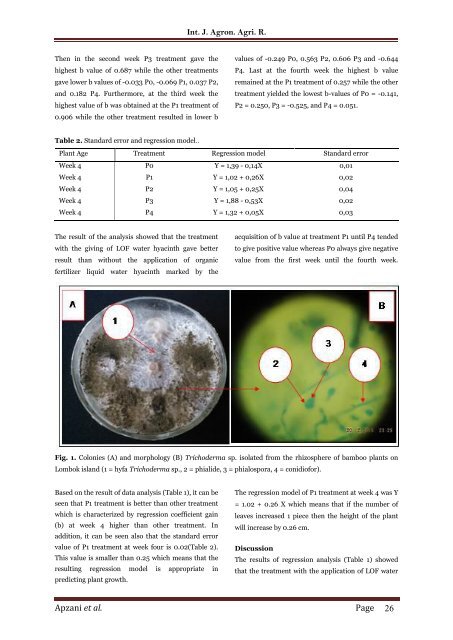Effectiveness of liquid organic fertilizer of hyacint (Eichhornia crassipes) Fermented by Trichoderma spp. for Growth of Lettuce (Lactuca sativa L.)
Abstract This research is important to be done with the aim to increase domestic lettuce production, development of area potency through the discovery of natural resources, and utilization of organic water hyacinth in Lombok island. This research was conducted at Green House Faculty of Agriculture University 45 Mataram. This study aims to determine the effectiveness of liquid organic fertilizer water hyacinth fermentation results Trichoderma spp. on the growth of lettuce. The research method used is experimental method with experiment in Green House. This research was designed using Randomized Complete Randomized Design (RAL) experiment with single factor experiment that is liquid organic fertilizer water hyacinth fermentation Trichoderma spp. which consists of 5 levels and 5 repetitions. The initial phase of the research was to arrange the experimental layout according to the treatment code of 25 experimental units, the planting of lettuce seeds, the provision of liquid organic fertilizer, irrigation, pest and weed management, and data collection. The next stage of data was analyzed by regression analysis to determine the effectiveness of fertilizer and the best dosage of fertilizer from the acquisition of regression coefficient value (b). Analsis results show that liquid organic fertilizer water hyacinth is effective in improving the growth of lettuce plants. Research shows that water hyacinth can be used as an alternative base liquid organic fertilizer that is cheap and easily available on the island of Lombok and has enough mineral content for the growth of lettuce plants.
Abstract
This research is important to be done with the aim to increase domestic lettuce production, development of area potency through the discovery of natural resources, and utilization of organic water hyacinth in Lombok island.
This research was conducted at Green House Faculty of Agriculture University 45 Mataram. This study aims to determine the effectiveness of liquid organic fertilizer water hyacinth fermentation results Trichoderma spp. on the growth of lettuce. The research method used is experimental method with experiment in Green House. This research was designed using Randomized Complete Randomized Design (RAL) experiment with single factor experiment that is liquid organic fertilizer water hyacinth fermentation Trichoderma spp. which consists of 5 levels and 5 repetitions. The initial phase of the research was to arrange the experimental layout according to the treatment code of 25 experimental units, the planting of lettuce seeds, the provision of liquid organic fertilizer, irrigation, pest and weed management, and data collection. The next stage of data was analyzed by regression analysis to determine the effectiveness of fertilizer and the best dosage of fertilizer from the acquisition of regression coefficient value (b). Analsis results show that liquid organic fertilizer water hyacinth is effective in improving the growth of lettuce plants. Research shows that water hyacinth can be used as an alternative base
liquid organic fertilizer that is cheap and easily available on the island of Lombok and has enough mineral content for the growth of lettuce plants.
You also want an ePaper? Increase the reach of your titles
YUMPU automatically turns print PDFs into web optimized ePapers that Google loves.
Int. J. Agron. Agri. R.<br />
Then in the second week P3 treatment gave the<br />
highest b value <strong>of</strong> 0.687 while the other treatments<br />
gave lower b values <strong>of</strong> -0.033 P0, -0.069 P1, 0.037 P2,<br />
and 0.182 P4. Furthermore, at the third week the<br />
highest value <strong>of</strong> b was obtained at the P1 treatment <strong>of</strong><br />
0.906 while the other treatment resulted in lower b<br />
values <strong>of</strong> -0.249 P0, 0.563 P2, 0.606 P3 and -0.644<br />
P4. Last at the fourth week the highest b value<br />
remained at the P1 treatment <strong>of</strong> 0.257 while the other<br />
treatment yielded the lowest b-values <strong>of</strong> P0 = -0.141,<br />
P2 = 0.250, P3 = -0.525, and P4 = 0.051.<br />
Table 2. Standard error and regression model..<br />
Plant Age Treatment Regression model Standard error<br />
Week 4 P0 Y = 1,39 - 0,14X 0,01<br />
Week 4 P1 Y = 1,02 + 0,26X 0,02<br />
Week 4 P2 Y = 1,05 + 0,25X 0,04<br />
Week 4 P3 Y = 1,88 - 0,53X 0,02<br />
Week 4 P4 Y = 1,32 + 0,05X 0,03<br />
The result <strong>of</strong> the analysis showed that the treatment<br />
with the giving <strong>of</strong> LOF water <strong>hyacint</strong>h gave better<br />
result than without the application <strong>of</strong> <strong>organic</strong><br />
<strong>fertilizer</strong> <strong>liquid</strong> water <strong>hyacint</strong>h marked <strong>by</strong> the<br />
acquisition <strong>of</strong> b value at treatment P1 until P4 tended<br />
to give positive value whereas P0 always give negative<br />
value from the first week until the fourth week.<br />
Fig. 1. Colonies (A) and morphology (B) <strong>Trichoderma</strong> sp. isolated from the rhizosphere <strong>of</strong> bamboo plants on<br />
Lombok island (1 = hyfa <strong>Trichoderma</strong> sp., 2 = phialide, 3 = phialospora, 4 = conidi<strong>of</strong>or).<br />
Based on the result <strong>of</strong> data analysis (Table 1), it can be<br />
seen that P1 treatment is better than other treatment<br />
which is characterized <strong>by</strong> regression coefficient gain<br />
(b) at week 4 higher than other treatment. In<br />
addition, it can be seen also that the standard error<br />
value <strong>of</strong> P1 treatment at week four is 0.02(Table 2).<br />
This value is smaller than 0.25 which means that the<br />
resulting regression model is appropriate in<br />
predicting plant growth.<br />
The regression model <strong>of</strong> P1 treatment at week 4 was Y<br />
= 1.02 + 0.26 X which means that if the number <strong>of</strong><br />
leaves increased 1 piece then the height <strong>of</strong> the plant<br />
will increase <strong>by</strong> 0.26 cm.<br />
Discussion<br />
The results <strong>of</strong> regression analysis (Table 1) showed<br />
that the treatment with the application <strong>of</strong> LOF water<br />
Apzani et al. Page 26


















